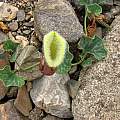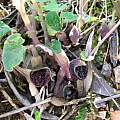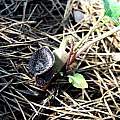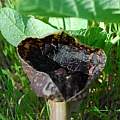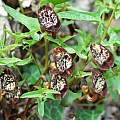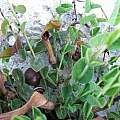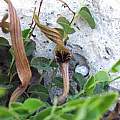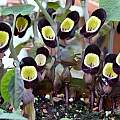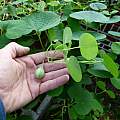Aristolochia L. is a large genus in the Aristolochiaceae family. Many members contain aristolochic acid which was once thought to be therapeutic and is now recognised as highly toxic. Some species from dry climates, such as A. chilensis and A. cretica, are geophytes with tubers and an annual dormant period.
Aristolochia chilensis Bridges ex Lindl. is from Atacama Desert south to the central region of Chile. Photograph by Eugene Zielinski taken in Spring 2011 between Huasco and Carrizalillo. This species trails along the ground, producing nicely marked leaves and interesting flowers, reflecting the common names of the genus, "Dutchman's pipe" and "pipe vine". It would be an appropriate garden plant in mild Mediterranean climates because it doesn't get very big or run underground. It is interesting because it comes in two flower color forms, one coastal and one inland. Height range: 15-30 cm.
Aristolochia guichardii P.H.Davis & M.S.Khan is a tuberous species from SW Turkey and the eastern Greek Islands, growing in rocky situations and pine forests at low elevations. Photos taken in its habitat in Antalya province, SW Turkey by Oron Peri.
Aristolochia hirta L. has a large, deep colored flower with noticeable white hairs. This tuberous species grows in the Eastern Aegean Islands and SW Turkey, blooming in March-April. Height range: 10-50 cm. Photos were taken in Antalya province, SW Turkey by Oron Peri.
Aristolochia lycica P.H.Davis & M.S.Khan is a lovely tuberous species with many maculated flowers. It grows in rocky places, often in Mediterranean scrub clearings at low elevations. It is endemic to Turkey and flowers from mid March to early May. Height range: 10-40 cm. The photo was taken in Antalya Province by Oron Peri.
Aristolochia parvifolia Sm. is a relatively common tuberous species in the E. Mediterranean, and the smallest. It grows in rock crevices or pockets in open fields or Mediterranean scrub; it has a long flowering season, December to May. Height range: 10-40 cm. The photo was taken on the Island of Rhodes by Oron Peri.
Aristolochia steupii Woronow is an endemic species with a very small distribution range in the western Caucasus (mainly in Abkhazia but also on the Russian side of the border), and it grows in humid deciduous forests. The climate is influenced by the Black Sea, with year-round heavy rainfall and mild, mostly frost-free winters characterizing the area. The contrasting black and yellow flowers are very striking. It forms fist-sized tubers from which numerous shoots develop in the spring. It flowers for several weeks after emergence. In late summer, the shoots die back. The new growth is already developed underground in the autumn and emerges above the ground over the winter. Height: to about 30 cm.
The species is rarely cultivated so far. Plant outdoors only in regions with mild winters; protect shoots from frost. Otherwise, plant in pots, kept cool but frost-free in winter, and placed outdoors in the summer. The substrate should be rich and well-draining (e.g., a mix of leaf compost and mineral components in a 50-50 ratio). Keep it consistently moist throughout the year, and never let it dry out even during its dormant period. Plants tend to grow better in large pots. Optimal light conditions are in dappled shade. Propagation by seed requires patience: the seeds typically germinate in the 3rd and 4th winter after sowing. The seeds should never dry out, so it's best to keep the sowing container inside a bag and regularly check for moisture. Germination occurs in winter. The relatively large seedlings can be easily pricked out. Expect flowering after approximately 3 years. Pictures by Eckhard Gottschalk.
